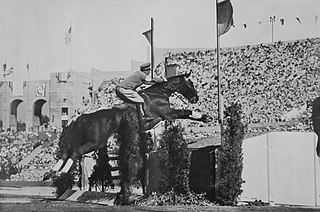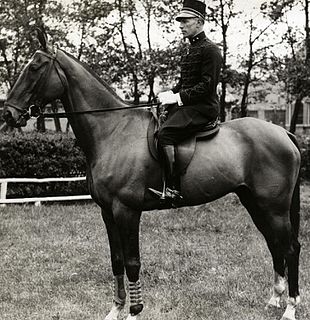At the 1900 Summer Olympics, five equestrian events were contested. Three of these had been considered "Olympic" by the International Olympic Committee in the past. The IOC website currently has affirmed a total of 95 medal events, after accepting, as it appears, the recommendation of Olympic historian Bill Mallon for events that should be considered "Olympic". These additional events include the other two equestrian events. It is not certain how many competitors there were, but it is likely that there were between 37 and 64. Calculation of number of competitors is complicated by the fact that a rider might enter an event multiple times on different horses. Five nations competed in the Olympic jumping events, with three more in the other two competitions. There were two female riders: Elvira Guerra, who competed in the hacks and hunter combined event, as well as a Frenchwoman "Moulin", whose first name is not known.

The equestrian program at the 1912 Summer Olympics in Stockholm, included five medal events. There were individual competitions in dressage, eventing, and show jumping. Team scores were also gathered and medals awarded for teams in the eventing and jumping competitions. Equestrian had been absent from the Olympic program since the 1900 Summer Olympics, making the 1912 Games the second time the sport was featured. Ten nations competed: Belgium, Chile, Denmark, France, Germany, Great Britain, Norway, Russia, Sweden, and the USA. Only Sweden and Germany were able to supply a full team for all three disciplines, with several countries having several riders and horses used in two or even all three disciplines. A total of 88 entries ran in the three events, with 62 riders and 70 horses.
The equestrian events at the 1920 Summer Olympics in Antwerp included eventing, show jumping, vaulting and dressage. The competitions were held from 6 to 12 September 1920. Although there were 89 riders competing, many rode in more than one event, with 87 entries total. Vaulting was also held, its one appearance at an Olympic Games, with only Belgium, France and Sweden fielding teams.

The equestrian events at the 1928 Summer Olympics included dressage, eventing, and show jumping. All three disciplines had both individual and team competitions. The competitions were held from 8 to 12 August 1928. Teams were now fielded by three riders, rather than four, the purpose being to reduce pressure on national federations to find that many riders in order to compete for team medals. Riders had to be considered amateurs, which was defined as either an actively serving professional officer, or as a gentleman rider as defined by the rules of that rider's national governing body. A total of 113 entries were present from 20 nations: Argentina, Austria, Belgium, Bulgaria, Czechoslovakia, Denmark, Finland, France, Germany, Hungary, Italy, Japan, the Netherlands, Norway, Poland, Portugal, Spain, Sweden, Switzerland, and the USA. This was the first appearance for Hungary, Japan and Argentina in equestrian events at an Olympics. Additionally, after being shut out from two Olympic competitions, Germany also returned to the Games to win a few medals in the equestrian events.

The equestrian events at the 1932 Los Angeles Summer Games included dressage, eventing, and show jumping. The competitions were held from 10 to 14 August 1932. Due to the Great Depression, only 31 entries from 6 nations competed—which was to be the lowest participation of any Olympic Games.
The equestrian events at the 1948 London Summer Olympics included dressage, eventing, and show jumping. All three disciplines had both individual and team competitions. The competitions were held from 9 to 14 August 1948, with the first five days held in the military complex at Aldershot, the endurance day on the army grounds of Aldershot at Tweseldown, and the jumping at the Empire Stadium in Wembley. World War II resulted in a greatly reduced number of competitors, including the absence of Germany, although Brazil made its first appearance in the equestrian events. 103 entries from 17 nations competed. The youngest participant was Aëcio Coelho from Brazil at 23 years old, while the oldest rider was the Italian Alessandro, Count Bettoni Cazzago, at 55 years old.
The equestrian events at the 1972 Summer Olympics in Munich included show jumping, dressage and eventing. All three disciplines had both individual and team competitions. The equestrian competitions were held at 3 sites: an existing equestrian facility at Riem for the individual show jumping and eventing competitions, the Olympic Stadium in Munich for the Nations Cup, and Nymphenburg, a Baroque palace garden, for the sold-out dressage. 179 entries, including 31 women, competed from 27 countries: Argentina, Australia, Austria, Belgium, Bolivia, Bulgaria, Brazil, Canada, Chile, Denmark, German Democratic Republic (GDR), France, Federal Republic of Germany (FRG), Great Britain, Hungary, Ireland, Italy, Japan, Mexico, the Netherlands, Poland, Portugal, Soviet Union, Spain, Sweden, Switzerland, and the USA. The youngest participant was Kurt Maeder from Switzerland at 19 years old, while the oldest rider was Lorna Johnstone from Great Britain at 70 years old.

Egypt boycotted the 1956 Summer Olympics in Melbourne, Australia, because of the British and French involvement in the Suez Crisis. The equestrian events for the 1956 Games, however, were held in Stockholm, Sweden, five months earlier, due to Australian quarantine regulations, and three Egyptian riders competed in the show jumping events. None of the athletes won individual medals and they failed to place in the team competition due to one rider's failure to finish the individual tournament.

Athletes from the Netherlands competed at the 1924 Summer Olympics in Paris, France. 177 competitors, 168 men and 9 women, took part in 81 events in 17 sports.
Equestrian competitions at the Beijing 2008 Summer Olympics were held from 9 August to 21 August at the Hong Kong Sports Institute and Sheung Yue River in Hong Kong. It was the second time that the equestrian events were hosted by a member of the IOC other than the member hosting the main games. Unlike 1956, however, the equestrian events were part of the main games, and were held within the same period.
The team jumping was an equestrian event held as part of the Equestrian at the 1912 Summer Olympics programme. It was the first appearance of the event. Unlike the team eventing competition, the team jumping was not simply a sum of scores from the individual jumping competition. Instead, riders competed in the team event separately a day after the individual event. Different riders could be used in the two events, and teams were limited to 4 riders while each nation could send 6 individuals.

Charles Ferdinand Pahud de Mortanges was a Dutch horse rider who competed at the 1924, 1928, 1932 and 1936 Olympics and was the flag bearer for the Netherlands in 1932. He is only one of three equestrians to win two consecutive Olympic titles in the individual three-day event. Besides his riding achievements, de Mortanges was president or vice president of the National Olympic Committee (1946–1961) and a member of the International Olympic Committee (1946–1964). He was also a top commanding officer of the Royal Netherlands Motorized Infantry Brigade in 1944–1945 and later a senior army official overseeing the official ceremonies involving the Dutch Royal Family.
Gerard Pieter de Kruijff was a Dutch horse rider who competed in the 1924 Summer Olympics and in the 1928 Summer Olympics.

Claës Henrik Magnus König was a Swedish nobleman, officer, Crown Equerry (1935–1946) and horse rider, who competed in the 1920 Summer Olympics and in the 1924 Summer Olympics.
One of the competitions in equestrian at the 1924 Summer Olympics was the individual eventing. The rules only allowed military officers to join the competition. From the results of the individual eventing, a team event was compiled.
The team jumping was one of five equestrianism events on the Equestrian at the 1924 Summer Olympics programme. Scores were the sum of the individual scores for the best three riders of each nation's four-man team. The competition was held on Saturday 27 July 1924. 43 riders from 11 nations competed. Czechoslovakia, with only three individual entrants, was the only nation to not send a full team.
The team eventing competition was one of six equestrian events on the Equestrian at the 1992 Summer Olympics programme. Dressage and endurance portions of the competition were held at the Club Hípic El Montanyà, the stadium jumping stage was held at Real Club de Polo de Barcelona. The scores of the top three rider/horse pairs for each nation in the individual event were summed to give a team score.
The team eventing at the 1960 Summer Olympics took place between 6 and 10 September. Eventing was open to men only. It was the 10th appearance of the event.
The team eventing at the 1968 Summer Olympics took place between 18 and 21 October. The event was open to men and women.






